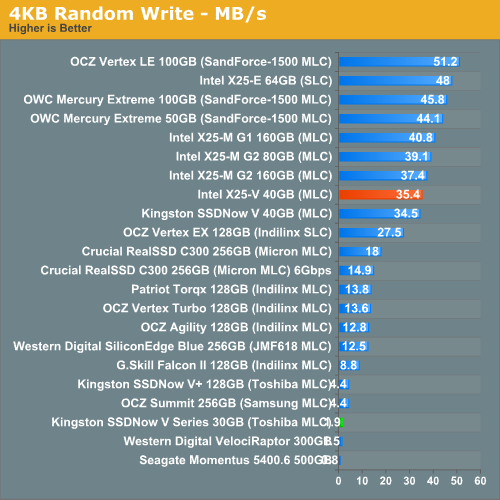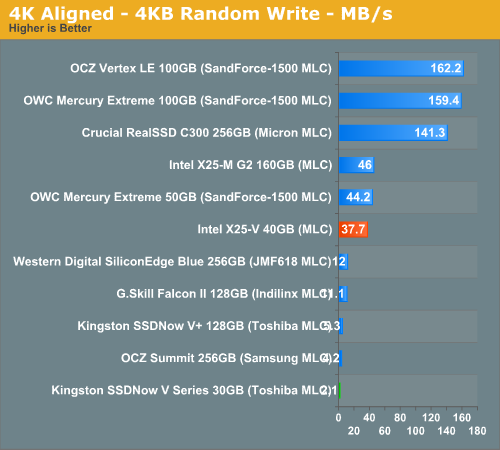Intel's X25-V & Kingston's 30GB SSDNow V Series: Battle of the $125 SSDs
by Anand Lal Shimpi on March 19, 2010 12:00 AM EST- Posted in
- Storage
Random Read/Write Speed
This test reads/writes 4KB in a completely random pattern over an 8GB space of the drive to simulate the sort of random access that you'd see on an OS drive (even this is more stressful than a normal desktop user would see). I perform three concurrent IOs and run the test for 3 minutes. The results reported are in average MB/s over the entire time.
I've had to run this test two different ways thanks to the way the newer controllers handle write alignment. Without a manually aligned partition, Windows XP executes writes on sector aligned boundaries while most modern OSes write with 4K alignment. Some controllers take this into account when mapping LBAs to page addresses, which generates additional overhead but makes for relatively similar performance regardless of OS/partition alignment. Other controllers skip the management overhead and just perform worse under Windows XP without partition alignment as file system writes are not automatically aligned with the SSD's internal pages.
First up is my traditional 4KB random write test, each write here is aligned to 512-byte sectors, similar to how Windows XP might write data to a drive:

Intel's drives have traditionally done very well in random write tests and the X25-V is no different. Here it performs like a much more expensive X25-M G2. The SSDNow V Series Boot Drive however is at the bottom of the charts in single digits here.
Running 4K aligned writes (similar to Windows 7 or OS X 10.5/6) doesn't improve the situation much in either case:

Random read performance is equally strong for Intel:

And equally weak for Kingston.










78 Comments
View All Comments
AnnonymousCoward - Monday, March 22, 2010 - link
410GB for apps, are you insane? The only way I can see that possible is if you store every warez app out there.Even my bloated work machine only uses 21.3GB.
davepermen - Saturday, March 20, 2010 - link
tell that to our work systems which have all sort of apps on + os (+office, sap, and many other things) and all have only a c:\ drive.it's perfectly doable. not for everyone (esp. not for gamers), but for more than people might imagine.
iwodo - Friday, March 19, 2010 - link
While the idea of $125 for 80GB Intel SSD is nice, but if we dont get any performance improvement over current Gen then market might wait again.SATA 3?
ONFi 2.0 / 2.2?
Faster Random Read / Write?
I really hope we get new Intel SSD controller.
Japunie - Friday, March 19, 2010 - link
I'd like to see some benchmarks showing time saved. That's my main issue with a benchmark. Most show a higher number, but don't exactly show yo uhow much time your saving.Gaming benchmarks are self-explanatory but I would love to see more benchmarks showing the time difference as that to me is the ultimate reason to upgrade not just to have the fastest card, what have you.
semo - Sunday, March 21, 2010 - link
i'm for more real world testing. fot consumer sata drives stuff like startup times and virus scans. for eneterprise sas drives i want to see exchange, sql, etc performance numbers.AnnonymousCoward - Saturday, March 20, 2010 - link
You're absolutely correct. I've posted this 3 times and emailed Anand directly, but he continues to ignore it.http://tinyurl.com/yjcr5vm">http://tinyurl.com/yjcr5vm
http://tinyurl.com/ylflfao">http://tinyurl.com/ylflfao
There's no question that he's dead wrong to not address the single thing that matters with hard drives: time. Without it you can't see how significant the difference between drives are, the AnandTech Storage Bench doesn't mean squat since drives like the SandForce use compression, and hard drives have a long history of performing differently in benchmarks vs real life. For proof of those last two points, check out http://tinyurl.com/yamfwmg">http://tinyurl.com/yamfwmg where RAID0 bought 20-40% more IOPS but zero load time.
The only SSD time benchmarks I know of here are Pages 29 and 30 of the very first review http://tinyurl.com/yd73sf8">http://tinyurl.com/yd73sf8. Whuddayaknow, the Vertex boots up 1.2s slower than the X25-M, and loads WoW realms 1.4s slower. How about that, something tangible and meaningful to compare.
Belard - Friday, March 19, 2010 - link
Don't they usually?The kinds of numbers that are easy to understand:
- Win7 boot time (after POST is preferred, but whatever)
- Loading of a game, loading of a game while doing a background task.
- virus scan
- Loading and saving a large file in Photoshop or Excel.
- Win7 Shutdown time.
- Win7 Wake up (perhaps to quick).
My own experience with Win7 and the intel X25-M-G2
Win7 boot:
1m25s = Temp 160GB HD SATA (not a fast drive)
0m09s = Intel SSD (same computer)
0m35s = Another PC with a typical 500GB 7200RPM drive.
Belard - Friday, March 19, 2010 - link
All the Sandforce drives are near the top, in general.But I'm not really seeing those drives out in the market? What are those prices like.
I have my experience with intels X25 G2 drives and they still seems to offer the best overall deal. Reliability, TRIM and price (now). The 80GB G2 is down to around $200... so spend an extra $80 and double the space to work with and vastly improve the performance over any of those drives.
A typical Win7 setup with NO user data is about 15GB, which mine is with various Adobe programs, 3 browsers, Office suite and dozens of add-ons. So a 30GB is barely enough for future usage. 40GB is fine, but the performance needs to be better IMHO in order for it to be an excellent desktop boot drive. In one of our desktops in an office, Win7 boots up about 8~10 seconds after POST. Everything is instant.
Scalptrash - Friday, March 19, 2010 - link
Less expensive, better specs. Hmmm...Ijiwaru - Friday, March 19, 2010 - link
newegg lists the 30GB at 89.99 standalone and 114.99(84.99 after MIR) for the kit.buy has the kit at 78.95 after MIR
amazon has the kit at 111.11